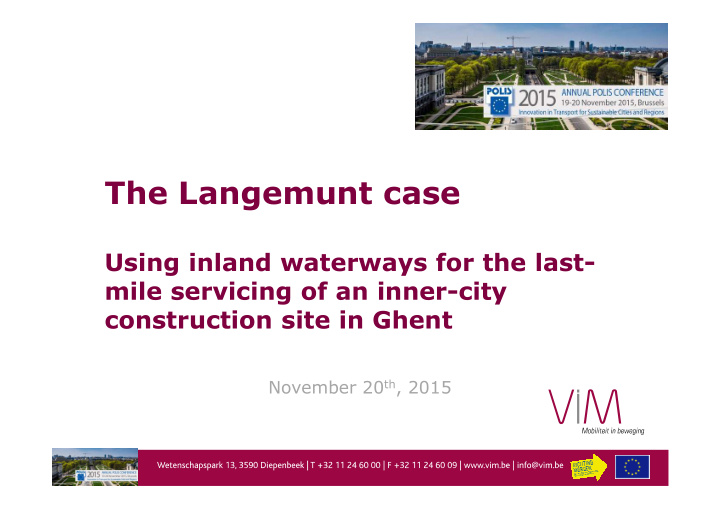



The Langemunt case Using inland waterways for the last- mile servicing of an inner-city construction site in Ghent November 20 th , 2015
Inner-city construction sites: culprit and victim The average construction site generates 80 (heavy) truck transports • In city centres, they affect general mobility and well-being • Pollution, noise, congestion • Parking space (Ghent 2014: 8% of total capacity) • At the same time, construction companies and developers experience • certain issues Sites cannot be reached or trucks are stuck in traffic • No parking near the site • Hardly any space to place dumpsters, etc • Opposition from residents, shopkeepers,… • 2
What happened previously: Distribouw Flemish waterway managers encourage the modal shift of unitized • building materials to IWT 2010-2011: “Build over Water”: 12,000 tons of unitized materials are • shipped during real-life trials in co-operation with 6 producers 2012-2015: Support of the roll-out of a hub-to-hub and hub-and- • spoke network called “Distribouw” as an EFRO-project 2014: specific trial cases (last-mile IWT and milk-run setup) • 3
The Langemunt case Reconversion of two medieval houses in the historical centre of Ghent 4
Site location Locked-in construction site • Pedestrian shopping area • Other (large) construction sites in the • immediate vicinity Available space very limited • But: site can be reached from the back • using the historic waterways Yet: very small waterway (locks, draft, • bridges) 5
Objectives of the pilot Financed by the waterway manager, the city council • and the real estate developer Executed by VIM • The goal is to determine costs and benefits for the • public and private parties involved if IWT is used Investigate feasibility and best practices for last-mile • delivery of construction materials using IWT Which vessel size/type? • Effects on number of trucks in the city? • Operational bottlenecks? • Effects on the planning of the works? • Which public parties (police, fire brigade, • tourism,..) have to be informed and/or involved? 6
Execution of the pilot March-Juli 2014: 10 transports • Delivery of construction • materials Removal of rubble, wood and • waste Use of barge with built-in, light- • weight hydraulic crane and a small pusher High intensity of communication • and coordination required Issues with water levels, locks,.. • In total 253 tons of cargo moved • using IWT 7
Operational costs Quite high, because: • Limited supply of suitable vessels • Vessels had to be relocated from other regions • Manning regulations (2 people at all times) • Adjustment of barge (cranes) • so costs can be reduced dramatically if: • Crane from the construction site can be used, vessels are • available in the area and can be operated (self-propelling) without the used of a pusher = 42% reduction More vessels of this type are available or long-term lease/rent = • further 9% reduction 8
Operational benefits 75 truck transports in the heart of the city avoided (congestion, • noise, pollution, safety,..) The surface of the barge offered a practical operational space buffer • which improved speed of operations No public space taken up by dumpsters, parked trucks,.. which was of • essence to the shop keepers in the area Experience with “smart construction logistics”, with a thorough • planning of the supply chain, resulted in an improvement of speed and continuity of construction operations 9
Lessons learned Handling costs can me decreased if, when more than one • construction site is in the area, the use of gantry cranes or quay space can be shared Precise planning required for the execution of transports (locks) • and intensive communication required (many parties involved) Local authorities and waterway managers should take up an active • role in facilitating the use of IWW (licences, use in public works, mobility policy, dredging, cargo quays..) 10
Impression (3’30”) 11
Recommend
More recommend